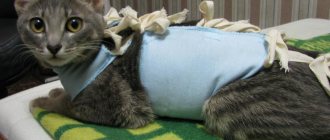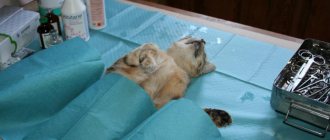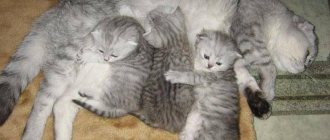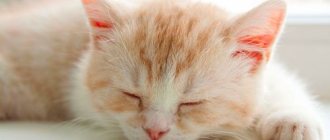When giving birth independently, your pet often experiences complications in the form of retained placenta. If the cat does not have an afterbirth, what should you do in this situation? This issue worries not only beginners, but also experienced breeders, as it poses a threat to the health and sometimes the life of the animal. This is due to the rapid development of not only the inflammatory process in the uterus, but also the threat of septicemia (blood poisoning). That is why it is important to quickly recognize the retention of the placenta and provide urgent assistance to the animal.
How to prepare for childbirth
A healthy female can give birth up to 5 times a year, so owners have to be careful to avoid accidental mating.
The question of how to find out when a cat lambs arises after a mating that happened without the knowledge of the owner. The owner needs to show her to the veterinarian to determine the timing of the birth of the offspring. Gestation lasts 9 weeks, preparation of the body begins in 7-10 days. You can find out that an important moment is approaching if you carefully monitor how the cat behaves before giving birth, as its habits change. She becomes restless and tries to hide. A characteristic sign of preparation is nesting syndrome, which is manifested by attempts to arrange a bed in a hard-to-reach place.
Feeding before birth
2-3 days before giving birth, the cat’s appetite worsens, which is considered normal. It is recommended to feed your pet 5-6 times a day in small portions. Remove foods that cause constipation/diarrhea from the diet and give liquid foods: broths, milk. Change the water frequently.
How to arrange a place
The birthing area is prepared in advance so that the pet gets used to it and knows where she will give birth to kittens. Otherwise, she will arrange the bed herself, choosing a secluded place under the sofa, bathroom or in the closet. Then it will be difficult for the owner to help the cat during childbirth.
How to prepare a place for a cat to give birth:
- Find a warm corner away from drafts and noise, where strangers, children, and pets have no access.
- Prepare a spacious box for mother and offspring.
- Cover the bottom with oilcloth, put a mattress on top, then moisture-absorbing diapers (not scented).
- Place bowls for food and water nearby, and a tray with filler not far from the box.
What to prepare from medicines, materials, tools
It is recommended to collect the first aid kit and auxiliary items in advance and keep it next to the box.
To give birth to a cat you will need:
- surgical gloves;
- syringes;
- sharp scissors with rounded ends;
- diapers (soft cotton fabric);
- sterile thread (preferably catgut from a veterinary pharmacy);
- 6-7 pcs. clean cotton towels for drying kittens;
- cotton swabs, sticks;
- pipette;
- sterile syringe with a rubber tip;
- a jar of water for placentas;
- petrolatum;
- alcohol, veterinary antiseptic solution (or brilliant green, hydrogen peroxide, iodine, chlorhexidine);
- antibiotic ointment;
- warmer;
- milk formula for newborn kittens (if the cat refuses to feed).
The following medications will be needed: Oxytocin , Sulfocamphocaine , sodium gluconate. Application and dosage should be agreed with your veterinarian. It is recommended to arrange a consultation or call with him in advance so that he can help the cat give birth at home.
Diagnostic definition of pregnancy
Some owners are interested in the question of whether it is possible to determine whether conception has occurred in an animal using a human test. Veterinarians give a clear answer that the test is not suitable for mustaches. It is possible to determine whether the female managed to become pregnant using ultrasound only after the first 2 weeks. After 5 weeks, the veterinarian will perform a palpation test and tell you how many kittens she will give you.
You can find out whether your pet managed to get pregnant using a clinical test for relaxin. This test can provide reliable information only 3 weeks after the expected day of the onset of an interesting situation; it requires blood plasma. The result will be ready in 10 minutes. You can determine whether your attempt to get pregnant was successful using an x-ray 5 weeks after mating.
How to understand that labor has begun
Symptoms of impending labor appear within 1-2 hours. The owner should stay close to the animal to monitor whether the water breaks.
Harbingers (signs) that a cat will give birth soon:
- loss of appetite, cat drinks often;
- you can see how the kittens move in their stomachs;
- there is discharge from the perineum, which the cat licks;
- nipples are swollen, colostrum appears when pressed;
- rectal temperature decreased to 37 °C;
- lethargic behavior: the cat is apathetic before giving birth and does not leave the box;
- 4-6 hours before lambing, false contractions develop;
- within 1-2 hours the birth plug comes out, then the waters pour out.
Mastitis.
Mastitis (inflammation of the mammary glands) in an acute purulent form sometimes develops during the first time after the onset of lactation. Inflammation is usually limited to one gland and can be caused by stagnation or production of large amounts of milk. The affected gland becomes tense, hot, painful and enlarged.
If the reason is only an overflow of milk, then, under the influence of heat and subsequent light massage, the milk comes out of the nipple, and the situation quickly normalizes. If inflammation begins, the cat begins to lose weight, becomes lethargic, febrile, and in addition to pain and swelling in the gland, redness with a noticeable accumulation of pus appears due to fluid pressure.
[custom_ads_shortcode3]
How does a cat give birth?
The timing of lambing varies depending on the breed. In veterinary practice, the end of pregnancy on the 65th day is considered the norm, and premature births are those that occur before the 60th day. No one will give a specific answer to the question of how long it takes a cat to give birth. The duration and nature of childbirth depend on the physical condition, age, presence of illnesses, and injuries.
How do contractions go?
4-6 hours before real birth, false (training) contractions develop. They prepare the kittens for exit from the womb, and the uterine vascular system for contraction of the organ after labor is completed to prevent bleeding.
You can tell that a cat is going into real labor by looking at its behavior. The animal arches, strains, screams. Then comes a period of rest. The intensity of contractions increases, the rest time between them decreases, and the size of the perineum increases.
How do kittens appear?
About an hour before the birth of the firstborn, mucus is secreted from the cat’s vagina, facilitating passage through the birth canal. The fetus comes out after 3-5 contractions while pushing head first. Further, the interval between kittens ranges from 5 to 30 minutes, but can last up to 1 hour.
How does the afterbirth come out?
Owners giving birth for the first time may not know what the placenta looks like. This is the placental sac (vesicle, baby's place) in which the fetus developed during pregnancy. During normal delivery, the membrane separates from the fetus and exits the birth canal immediately after the kitten or after a couple of minutes.
If the placenta (or part) remains inside the body, it means that the birth is complicated. Therefore, it is important to monitor the number of newborns and placentas. The number of kittens a cat gives birth to is the number of shells that must come out. If the baby's place stays inside for more than 3 hours after the end of labor, intervention (surgery) is required, otherwise internal inflammation will develop.
Duration of labor
The first lambing in nulliparous cats lasts longer than subsequent ones. The beginning is considered to be the appearance of frequent contractions, the end is the release of the last fetus. How long labor lasts depends on many factors. The norm is 12-18 hours. If lambing continues for more than 24 hours, veterinary assistance is required. If the cat cannot give birth for more than 2 days, a cesarean section is performed.
How many kittens can be born?
The average number of individuals in a litter is 3-8. Young cats bear 1-3 kittens, since the reproductive system is not fully formed. The same offspring are produced by older individuals, since reproductive function fades with age. Otherwise, it is impossible to predict without an ultrasound how many kittens a cat can give birth to.
Appearance of healthy newborn kittens
Babies are born helpless, with closed eyes, ear canals, and toothless. The coat is thin, there is no undercoat. The average weight of babies is 80-110 g, length – 9-12 cm, temperature – 36.1 °C.
Healthy kittens have a well-developed sense of smell and touch. They immediately find and apply to the mother's nipples.
How to understand that labor is over
If, after the birth of the next kitten, the cat remains in place, refuses to drink and eat, and reluctantly licks the offspring, it means that lambing is not completed.
Other signs will also help you understand that your cat has finished giving birth:
- more than 40 minutes have passed since the last calf emerged;
- the abdomen is soft, no lumps are detected when palpated;
- breathing is smooth, cardiac activity is normal;
- the animal changes its body position and leaves the box;
- actively cares for offspring;
- appetite appeared.
It can sometimes be difficult to understand that a cat has given birth to all her kittens. However, it is necessary to make sure of this so as not to miss the inflammatory process due to the fetus remaining inside.
Pathological birth
The risk of complications always exists, so the owner should monitor changes in the pet’s behavior. Then he will be able to help the cat during childbirth.
Non-psychological factors of complicated labor include:
- Mechanical blockade. Occurs when the size of the fetus exceeds the diameter of the birth canal, and contractions are too weak to push it through. The second reason for difficult childbirth in cats is incorrect presentation of the fetus (sacrum or tail forward).
- Atony of the uterus. Sluggish contractions occur due to stretching/expansion of the uterus, multiple pregnancies, dropsy, lack of oxytocin and/or calcium in the body.
If the fetus is stuck in the birth canal, then the owner needs to put on a glove and lubricate it with Vaseline. Carefully insert your fingers inside and grab the kitten by the withers. You can’t pick it up by the paws: they can be dislocated or broken. Carefully remove the fruit using smooth rocking movements.
A doctor's help will be needed if a dark, foul-smelling fluid is released from the cat's birth canal, the intervals between contractions have increased, or labor has been prolonged.
What to do when kittens are stillborn
If offspring appear without signs of life, resuscitation will be required. If the efforts made are ineffective, the corpses should be removed from the box and placed in separate bags. After birth, the cat should be taken for postmortem analysis to determine the cause of death.
What to do when newborn kittens are not breathing
If the kitten is lifeless and the mother is indifferent to it, the owner needs to carry out resuscitation actions:
- Turn the kitten head down and, holding it, shake the body so that liquid flows out of the mouth and lungs. Suck out the remainder with a syringe.
- Blow 2-3 times into your nose and mouth (not too much, otherwise your lungs will be damaged).
- Check your heartbeat. If absent, begin resuscitation: rhythmically compress the chest with your index finger and thumb at heart level. Press quickly, but not hard. Blow air into the kitten's nostrils every 15-20 seconds. If a heartbeat appears, stimulate the rhythm: turn the body over, take the baby by the withers, dry him with a towel. It may take a couple of repetitions of resuscitation to get the kitten to breathe.
The duration of cardiopulmonary stimulation is 20 minutes in the presence of a heartbeat. If the kitten does not breathe within 5 minutes of the procedures, you will have to accept death.
Mastitis.
Mastitis (inflammation of the mammary glands) in an acute purulent form sometimes develops during the first time after the onset of lactation. Inflammation is usually limited to one gland and can be caused by stagnation or production of large amounts of milk. The affected gland becomes tense, hot, painful and enlarged.
If the reason is only an overflow of milk, then, under the influence of heat and subsequent light massage, the milk comes out of the nipple, and the situation quickly normalizes. If inflammation begins, the cat begins to lose weight, becomes lethargic, febrile, and in addition to pain and swelling in the gland, redness with a noticeable accumulation of pus appears due to fluid pressure.
[custom_ads_shortcode2]
When is labor induction needed?
It is up to the veterinarian to decide what to do if the cat cannot give birth. Otherwise, an incorrectly determined reason for the delay in birth will lead to complications or death of the pet.
Stimulation is carried out when there is a prolonged interval between the birth of kittens (1-3 hours) or late lambing. Before inducing labor in a cat, you need to make sure that the measures taken will not harm her.
Stimulation of the uterus begins with a gentle massage of the abdomen and nipples. The administration of oxytocin is used in emergency cases, if it is established that there is no mechanical blockade. The decision to give an injection is made by the doctor, since an incorrect dose of the administered medication will cause rupture of the cervix, death of the kittens and/or the mother in labor.
Why is it dangerous?
For an animal, such a pathology can result in infection entering the bloodstream.
Detention of the birth place can be partial or complete. If we talk about the latter, the afterbirth does not separate completely. A partial delay is observed when the shells do not come out completely. Both of these conditions are fraught with the rapid onset of inflammatory processes, since the open birth canal infects pathogenic microorganisms. As a result, purulent inflammation of the uterus is often observed. Pathogenic bacteria enter the bloodstream, spreading throughout the body and causing blood poisoning. As a result, the cat experiences serious intoxication of the body after giving birth.
What happens to a cat after giving birth?
The mother needs time to recuperate after lambing. It is necessary to monitor her condition so as not to miss alarming symptoms.
Normal state
For the first 5-7 hours (sometimes 24 hours), the mother may refuse to eat, which is considered normal if she actively laps up water. Trips to the litter tray may be suspended temporarily (up to 4 days). It is also possible for pink discharge to appear in the first 7 days after birth.
As for when a cat begins to produce milk, the norm is immediately after birth, when the first-born kitten begins to suckle. Minor delays due to stress are acceptable. After a short time, the cat will calm down and lactation will improve. Next, it is necessary to provide the woman in labor with peace, fresh food, and drink so that the milk does not disappear.
Signs of complications
Deterioration of condition after lambing is more often observed in very young, injured and purebred individuals. Domestic cats that are constantly in the fresh air and actively moving have stronger bodies, so difficult childbirth is practically excluded.
Pet owners need to monitor behavior to spot adverse symptoms early.
You should consult a doctor if you experience any of the following symptoms:
- the cat is anxious, restless or apathetic;
- no appetite for more than 24 hours;
- body temperature changed sharply: increased to 39.4 °C or fell below 36.1 °C;
- bleeding continues for more than 10 minutes;
- milk of abnormal color and/or consistency (yellowish, transparent, curdled);
- persistent vomiting and/or diarrhea;
- paws and/or head trembling;
- purulent or foul-smelling discharge within 3 weeks after birth;
- nipples are very hot and swollen;
- The cat doesn't care about kittens.
In females with very large offspring, milk fever (eclampsia) may develop due to a sharp decrease in calcium concentration in the body.
Signs of pathology in a cat:
- anxiety;
- rapid breathing;
- pallor of the mucous membranes;
- lack of coordination of movements;
- pointed muzzle with exposed fangs;
- temperature jump to 41.1 °C;
- convulsions, loss of consciousness.
Late signs of pregnancy detection
More precisely, it is possible to say whether conception has occurred in about three weeks. The following symptoms will help you understand:
- You can use palpation to determine the presence of embryos in the tummy. Pressure must be done very carefully so as not to harm the babies. Too harsh an examination can cause a miscarriage.
- The mammary glands and nipples become swollen and acquire a brighter color.
- There is a sharp increase in appetite, and variability in the perception of foods may occur. Previously consumed food may be rejected, and interest in previously unloved food may appear.
- At 3-5 weeks, the tummy becomes rounded.
- When they reach 6 weeks, the kittens can be palpated.
- At 7-8 weeks, it is possible to notice the movement of the babies, feel the heartbeat, and identify the head and body.
Caring for cats and kittens after birth
The box should be cleaned and soiled diapers replaced with clean ones. Place the box with the family in a quiet place. Observe behavior: if there was a simple birth, without complications, then the mother is calm, focused on licking and feeding the children. To eliminate stress and cessation of lactation, you will have to temporarily limit the visits of guests.
Further care for the cat that has given birth comes down to ensuring cleanliness and nutrition. It is recommended to keep the tray and bowls close to the box so that the mother is close to the offspring. Feed 5 times a day, give vitamins for newborn cats.











